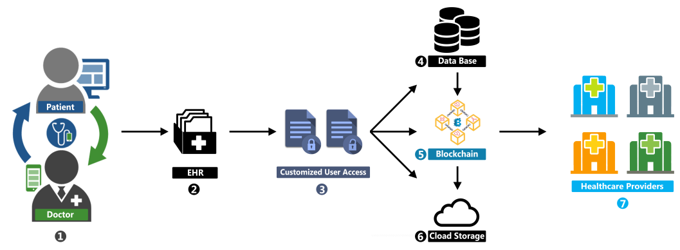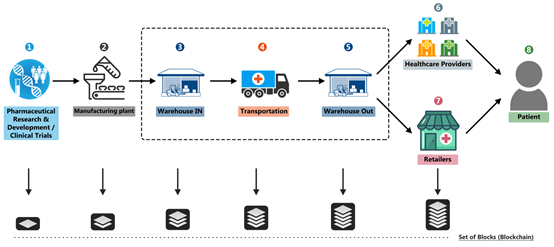Babbitt Column | A Guide to the Application of Blockchain in Healthcare
In this section, we will introduce the medical data sharing mechanism based on blockchain. From these cases, we see the role of blockchain in medical data sharing. It has a good reference for building systems in other fields.
With the development of electronic medical data, the advancement of cloud healthcare data storage and patient data privacy protection regulations, the management of medical data and the access and sharing of medical data by patients have ushered in new opportunities.
Protecting data security, storage, transactions, and unified management of this data are extremely valuable to any data-driven organization, especially in the medical and health field.
Blockchain technology has the potential to address these key issues. The following figure shows the seven steps of the medical data management workflow in the blockchain.
- On-chain data February scan: Coin price roller coaster, boosting on-chain data, is there a relationship between the two?
- Insert pins up and down at night, dish washing continues
- Ethereum mining shuffle: nearly 40% of the entire network computing power in April or will evaporate

• Step 1: The main data is generated by the interaction between the patient and their doctor. This data includes medical history, current problems and other treatment information.
• Step 2: Use the main data collected in the first step to create an EHR for each patient. Other medical information, such as information generated from nursing, medical imaging, and drug history, is also included in the EHR.
• Step 3: Patients with EHR ownership have the right to customize access rules and grant access to other users. All parties wishing to access such valuable information must ask the EHR owner for permission, and the owner will decide who grants access.
• Steps 4, 5 and 6: These three steps are the core part of the whole process, including database, blockchain and cloud storage. Databases and cloud storage store records in a distributed manner, while blockchain provides great privacy to ensure access by real users.
• Step 7: Medical service providers such as temporary clinics, community care centers, and hospitals are end users, and they want secure, reliable medical services authorized by the user. For example, no matter if you are being treated anywhere in the world, your health record will be available and accessible on your phone and verified through a distributed ledger such as a blockchain. These records will continue to be added.
Application areas based on blockchain include:
-
data sharing -
Data management -
Data storage (for example, cloud-based applications) -
EHR
The following discusses the solutions in each area one by one. Firstly introduce the medical data sharing based on blockchain.
Medical data sharing
Sharing medical health data is the main and essential step to improve the quality of medical institutions and make medical systems smarter.
Individuals may share medical health records. For example, a patient needs to share his medical history with a doctor when they first meet. In addition, sharing may occur between individuals and stakeholders, such as sharing patient medical records with insurance companies or research centers.
Data can even be shared across boundaries. However, there are some limitations to the operating mechanisms of health-related systems today. One limitation is that patients have little access to their health records. As a result, they have no way of knowing which institutions their health data is shared with.
In order to improve interaction and collaboration with the healthcare industry, blockchain technology can play a key role in promoting a more convenient mechanism for sharing electronic medical data. This is considered to be one of the most critical contributions in the field of healthcare based on blockchain. Below, we describe some of the contributions made in this regard.
Castaldo and Cinque et al. Proposed a logging system that uses a private blockchain to facilitate and improve the exchange of electronic health data between multiple European countries in the most secure way.
Yue et al. Developed a medical data sharing application based on the blockchain architecture, namely a medical data gateway (HGD). The solutions they provide help patients easily control and share data without compromising privacy. They provide a way to make healthcare systems smarter, while keeping patients' data private.
In addition, Vishal Patel proposed a cross-domain image sharing framework that uses blockchain technology as a distributed data store to create a ledger of radiology image data and allows users to control the image sharing themselves.
In a similar study, Fan et al. Developed a MedBlock framework based on blockchain technology to solve data management and data sharing issues in electronic medical record (EMR) systems and improve medical information sharing. By avoiding the fact that the previous medical database is separate, patients can access the EMR of different hospitals through the MedBlock framework. In addition, data sharing and collaboration through the blockchain can help hospitals understand the patient's medical history before consultation.
Ji et al. Proposed a multi-level location sharing scheme based on blockchain technology. The purpose is to realize the privacy-protected location sharing of the blockchain through the telemedicine information system. They defined the main requirements for decentralized location sharing, confidentiality, variability, and multiple layers of privacy protection, unretrievability, and unforgeability through the use of Merkle trees and Shun Bao encryption. The experimental results show that the scheme is feasible for patients and medical staff, and can be applied to the protection of location information in the telemedicine information system.
Shen et al. Proposed MedChain, an efficient conversational medical data sharing based on blockchain. MedChain uses a digest chain structure method to check the integrity of the shared medical IoT data stream. This is done to overcome the efficiency issues of existing systems such as Medrec and MedBlock. The evaluation results show that MedChain can achieve higher efficiency and meet the security requirements for healthcare data sharing.
Medical data management
Many companies driven by data, especially medical institutions, generate large amounts of data every day. However, data security and privacy are unintentionally or intentionally used by illegal users. As a result, many institutions have experienced huge losses in reputation and capital.
Different users of medical data should have different roles, and access to the data should be controlled by the access rights assigned to these roles. This access method can be solved naturally through blockchain technology. Below, we describe some blockchain technologies developed for this purpose.
MedRec is a decentralized electronic data management system, in which data permissions and operations are recorded in the blockchain and executed through smart contracts. MedRec collaborates with providers to complete the authentication, confidentiality, auditing and sharing of medical data, and provides patients with comprehensive, non-tamperable medical data services.
In another study, Zhu et al. Proposed a method for implementing controllable blockchain data management in a cloud environment to address users' concerns about lack of control over ledger data. In their model, they designed a special trust authority node to enable users to terminate and prevent any potentially malicious operations even in most attacks.
Another contribution of Genestier et al. Proposed a new idea of re-entrusting "consent management" in the medical system, which mainly provides users with the blockchain to control the entire health record data. However, there is no authorization design or access control in its implementation.
Medical data storage (cloud-based applications)
In a blockchain-based medical system, each transaction is stored in a block of the blockchain, and the blockchain is a decentralized storage method that is distributed among various nodes.
In the healthcare system, patient medical data is organized in the form of EHRs (Electronic Medical Records) and is considered to be the basis for large distributed medical storage. HER can be stored locally or in the cloud for security reasons.
Cloud storage is mainly composed of many storage devices. All storage devices are connected together to form a large amount of storage to accommodate a large amount of information infrastructure. A blockchain-based medical system is an example of such an IT infrastructure. The advantages of cloud storage technology are fast transmission speed, good sharing, large storage capacity, low cost, easy access and dynamic association.
Al Omar et al. Proposed a patient-centric medical data management system that uses blockchain technology as the storage in the cloud environment, which helps to obtain privacy. The main idea of this work is to achieve auditability, integrity, and security by defining a set of security and privacy requirements, thereby storing privacy-related medical and health data on the blockchain.
However, Kaur et al. Introduced a new term, BlockCloud, which actually integrates with the blockchain in a cloud environment. The idea is to keep data distribution and security in the same environment without involving third parties. This research addresses the challenges that need to be addressed by healthcare providers, public health agencies, and governments to collaborate and develop policy implementation.
Electronic medical records
Traditional medical records are paper-based, and the chronological order of tracking a patient's health is cumbersome. They are also prone to erroneous data and sometimes lead to misdiagnosis of patients.
The introduction of electronic medical records can reduce these disadvantages. Electronic medical records allow doctors to significantly improve the quality of treatment. In addition, EHR can improve disease management and preventive care. In addition, digital records provide better decision support and increased collaboration between agencies. As a result, people are becoming more aware of its role in the medical community and doing a lot of research work to design blockchain technology to protect, share and store EHR data within and between institutions.
Chen et al. Designed a secure cloud storage for patients' personal privacy medical records, and developed a secure blockchain framework for medical data sharing. In this framework, medical data management is achieved through the use of digital archives, which have access to owner information. Store by deploying cloud encryption off-chain.
In related research, Guo et al. Introduced an attribute-based signature scheme that utilizes blockchain technology with multiple permissions to guarantee and verify EHR. It facilitates the broadcast of group messages and is resistant to collusion attacks.
Wang and Song proposed a cloud computing secure electronic medical record system based on blockchain and attribute-based cryptosystem. To encrypt medical data, they used a combination of identity-based encryption and identity-based signatures to implement digital signatures. On top of this blockchain, other technologies are also used to ensure the integrity and traceability of medical facilities.
The above three studies are mainly focused on the cryptography of protecting EHR blocks. However, Roehrs et al. Proposed some new research to solve the problems related to the harmonization of medical records scattered in different places and the management of access by stakeholders. These two problems were solved by presenting OmniPHR, a distributed model for integrating personal health records (PHR), which uses a parallel database to store PHRs in blocks and combines structural semantic interoperability and different PHR The format is updated uniformly.
Hussein et al. Developed a framework with a completely different approach that uses blockchain technology based on genetic algorithms and discrete wavelet transforms to protect medical records. The proposed method utilizes an improved password hash generator to generate the necessary user security keys. In addition, by using discrete wavelet transform, MD5 strings are used to generate a new key format. This method enhances the security of general systems and can resist various attacks.
In this part, we introduce the application of blockchain in supply chain management in the medical field.
Supply Chain Management
SCM (Supply Chain Management) aims to increase the efficiency of the industry to streamline the entire delivery process from ordering to supply. Supply chain management has broad application prospects in the medical field.
Because orders for medical supplies, medicines, and key resources are distributed sequentially, there is a risk of jeopardizing the supply chain process, which may directly affect patient safety.
According to a study by the World Health Organization (WHO), more than 100,000 people in Africa have died from counterfeit medicines ordered by their suppliers and from improper doses. In addition to counterfeit products and medicines, the lack of product registration and packaging errors in medical institutions can damage the entire SCM.
Blockchain is the key monitoring technology to enter the entire process of drug and medical product transportation. Since all transactions are recorded on the ledger, and each node in the blockchain keeps a record of transactions, it is easy to immediately verify the origin of drugs, suppliers and distributors.
In addition, the blockchain's distributed ledger allows medical agency officials and doctors to check and verify vendor credentials. With a proper and timely certification process and a deeper understanding of the supply chain, pharmacies and medical provider providers can ensure a reliable flow of medicines into the hands of patients who need them most.
In this regard, blockchain technology has broad prospects for building a trusted supplier network, enabling healthcare administrators to protect patients from reputable vendors. In addition, blockchain technology is expected to greatly improve demand forecasting, data traceability, fraud prevention and transactions. The following figure illustrates the pharmaceutical SCM process using blockchain technology.

• Step 1: When a new drug or medical health method is invented, a block will be created that includes patent protection and a long-term clinical trial process. This information is recorded in the blockchain ledger as a form of transaction.
• Step 2: Once the clinical trial is successful, the patent is sent to the manufacturing plant for trial prototype and mass production. Each product has its own unique identity, integrated with another transaction or block in the blockchain, including other relevant information.
• Step 3: Once the mass production and packaging is complete, the medicines are gathered in the warehouse for future distribution. The blockchain contains information such as time, batch number, barcode, expiration date, and so on.
• Step 4: Shipping information is also included in the blockchain, which may include timeouts from one warehouse to another, shipping methods, authorized agents, and other information.
• Step 5: Third-party distribution networks are typically responsible for distributing medicines and medical supplies to healthcare providers or retailers. Each third-party repository is used for this purpose, and all distribution endpoints are linked from here. Individual transactions are also integrated into the blockchain.
• Step 6: Care providers such as hospitals or clinics need to provide information such as lot number, product owner, expiration date to verify identity and prevent counterfeiting. This is also included in the blockchain.
• Step 7: The retailer takes a similar action to step 6.
• Step 8: Patients are encouraged to determine authenticity throughout the process as the blockchain supply chain provides transparent information to potential buyers for verification.
Clinical Trials
Clinical trials in the healthcare sector face many challenges, including personal data privacy, data sharing, and patient admission. Blockchain technology has the potential to solve these challenges. It provides models for sharing clinical trial data that can safely achieve transparency and repeatability.
Nugent et al. Proposed smart contracts on the Ethereum private network to address the issues of reduced trust and enhanced clinical trial data transparency. The purpose of this study is to increase the scientific credibility of the results of clinical trials, which may be compromised by problems such as lack of data.
To enhance clinical trials and precision medicine, Shae and Tsai et al. Developed four new system components on top of traditional blockchains. These include blockchain-based distributed and parallel computing prototypes for big data analysis; data management components for data integration; identity management components for privacy protection of IoT devices; data sharing management components for collaborative research ecosystems .
In another study, Choudhury et al. Proposed a new data management framework based on licensed blockchain technology using smart contracts. The purpose of this study was to reduce the administrative burden, time, and workload of ensuring data integrity and privacy in multi-site clinical trials.
Benchoufi et al. Developed a permission-based workflow based on the clinical trial methodology. They collect permissions based on timestamps, including registration of smart contracts. Data traceability ensures the verifiability and transparency of such extremely sensitive data, even when the complete document is stored in a public store, such as a dedicated public website.
Pharmaceutical Industry
Pharmaceutical companies have been working tirelessly to improve the quality of their medicines and to invent new medicines for many diseases. Such drugs need to go through a lengthy process to ensure patent protection, safety, efficacy, statistical validity, and regulatory approval. Usually, this process takes many years, from discovery to commercialization, with clinical trials accounting for most of the process.
Therefore, due to the lack of security and privacy, this long process can easily lead to drug recalls and counterfeiting. This obstacle can be eliminated by using blockchain technology throughout the pharmaceutical process.
We can preserve privacy and ensure security by using the blockchain distributed ledger by ensuring that each trial event is recorded in a tamper-resistant blockchain node.
Private blockchains can be used to ensure that all medicines comply with patent protection. This can provide completeness, traceability and transparency by using smart contracts.
According to a recent study, about 60% of pharmaceutical companies are or are trying to use blockchain, which reflects the potential of blockchain in the industry. Counterfeit medicines are a global problem and pose great challenges to the public and consumers.
Sylim et al. Developed a drug monitoring blockchain system in a simulated network to test the feasibility of applying this technology and its principles to drug monitoring systems. The goal is to improve the traceability of counterfeit medicines. The system can resist traditional counterfeit drug supply chains, which is a major problem for some Asian countries.
In many ways, Gcoin (Global Management Coin) provides a dynamic role for each node (including coin issuers, full nodes, miners or ordinary nodes) in a hierarchical relationship for pharmaceutical SCM. Tseng et al. Suggested using the Gcoin blockchain as the basis of the drug data stream to create transparent drug transaction data. Share among manufacturers, wholesalers, retailers, pharmacies, hospitals and consumers. Records of drug transactions can transform the drug supply chain from supervision (government audit) to supervision (each participant works together).
In addition, the regulatory model of the drug supply chain can be changed from review and inspection to a supervisory network model. For more than a decade, radio frequency identification (RFID) technology has been considered a reliable retainer of ownership, but beyond the trusted areas of RFID, such as post-supply chain networks, it is easy to forge by cloning the identification. By exploiting the Ethereum platform and its wallet, such vulnerabilities can be eliminated throughout the supply chain from the manufacturer to the end customer.
Blockchain use cases in supply chain management
• Claims and bills management
Health care services have their own costs that have made the entire industry worth one trillion dollars and are growing rapidly. The medical billing process is an integral part of the healthcare sector. This is because without billing and without billing, correct service delivery cannot be guaranteed. This process begins with the patient's admission to checkout. It involves several steps such as registration, confirmation of financial responsibilities, compliance with records and bills, referral of claims and receipt of payments from insurance companies.
The entire billing plan can be challenging because some of these costs are paid entirely by the patient's personal health insurance plan or by the patient. One of the major problems with medical billing is overcharging due to a lack of transparency and trust between doctors, patients and insurance companies. Claims and bills in the healthcare industry continue to be abused, but claims can be resolved or reduced by using a transparent system for each stakeholder. Blockchain can ensure this transparent system that enables everyone to participate in the entire process and eliminates distrust between them.
• Quality Management
If the drug contains incorrect ingredients, the drug is considered counterfeit and is intended to hide or imitate its provenance, authenticity or even effectiveness.
In addition, products and counterfeit medicines have a significant impact on SCM. Their performance in the pharmaceutical industry is a competitive factor that greatly undermines the efficiency, authenticity, and strong profitability of specific healthcare industries.
Customers often don't know the exact source of the products they buy and consume in global markets. Because the drug is malicious to patients, it is a life-threatening problem worldwide. This also threatens the reputation of the original pharmaceutical company, causing drug manufacturers and distributors to invest a lot of money in countermeasures.
Studies have found that techniques such as spectroscopy and chromatography are effective in detecting counterfeit products because they detect active ingredients and image sample components. However, they have their limitations because it relies on electromechanical equipment, which increases management costs. One way to solve these challenges is to have the information of the drug manufacturer on the blockchain, including the product serial number and packaging number, so that pharmaceutical companies, drug manufacturers and customers can verify the authenticity of the data by connecting to the blockchain . This process ensures low-cost quality control, product registration, drug tracking and counterfeit medicines throughout the SCM process.
We will continue to update Blocking; if you have any questions or suggestions, please contact us!
Was this article helpful?
93 out of 132 found this helpful
Related articles
- South Korea's Special Financial Law and Market Analysis: Cryptocurrency finally welcomes its name after 4 years of regulatory "passiveness"
- DeFi Ventures Framework announces $ 900,000 investment in Commonwealth Labs and FutureSwap to complement DeFi's missing link
- Bitcoin's Secret History: The Price of Bitcoin Has Changed
- Why India's lifting of crypto ban is the biggest positive factor in 2020
- Where will the safe-haven funds go after Black Monday?
- Telegram says recent ruling "fundamentally" overturns SEC ban
- Dialogue | Where is the Blockchain in the New Infrastructure?






